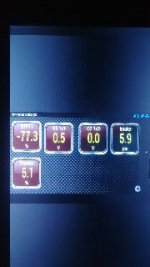NebulaStilo
Member
- Joined
- Jul 18, 2019
- Messages
- 220
- Points
- 50
Hi guys.
So as some may remember me. I have a 1.6 stilo and it had a cone filter(straight replacement) no induction kits. Car was pulling sluggish and hesitation in acceleration as time went by after having fitted this cone because of a cracked box.
CEL on with downstream o2 sensor which shouldn't affect performance AND there is no CAT. Previous owner done decat.downstream o2 is completely dead,no values.p0141 is the code. O2 values and STFT are steady ish at idle but become very erratic when driving hence the hesitation.(before replacing cone with box)
I eventually got hold of a used box in good condition with the panel filter in.
I am going to replace the paper filter inside though.
I fitted it and drove the car. It started much easier and idles smoother.
She pulls still abit sluggish but seems to be getting better. Only took it for one test.
I want to know,does the ECU need to readjust(relearn) what's happening with the standard box coming from the cone filters high air flow?
Thanks
So as some may remember me. I have a 1.6 stilo and it had a cone filter(straight replacement) no induction kits. Car was pulling sluggish and hesitation in acceleration as time went by after having fitted this cone because of a cracked box.
CEL on with downstream o2 sensor which shouldn't affect performance AND there is no CAT. Previous owner done decat.downstream o2 is completely dead,no values.p0141 is the code. O2 values and STFT are steady ish at idle but become very erratic when driving hence the hesitation.(before replacing cone with box)
I eventually got hold of a used box in good condition with the panel filter in.
I am going to replace the paper filter inside though.
I fitted it and drove the car. It started much easier and idles smoother.
She pulls still abit sluggish but seems to be getting better. Only took it for one test.
I want to know,does the ECU need to readjust(relearn) what's happening with the standard box coming from the cone filters high air flow?
Thanks





